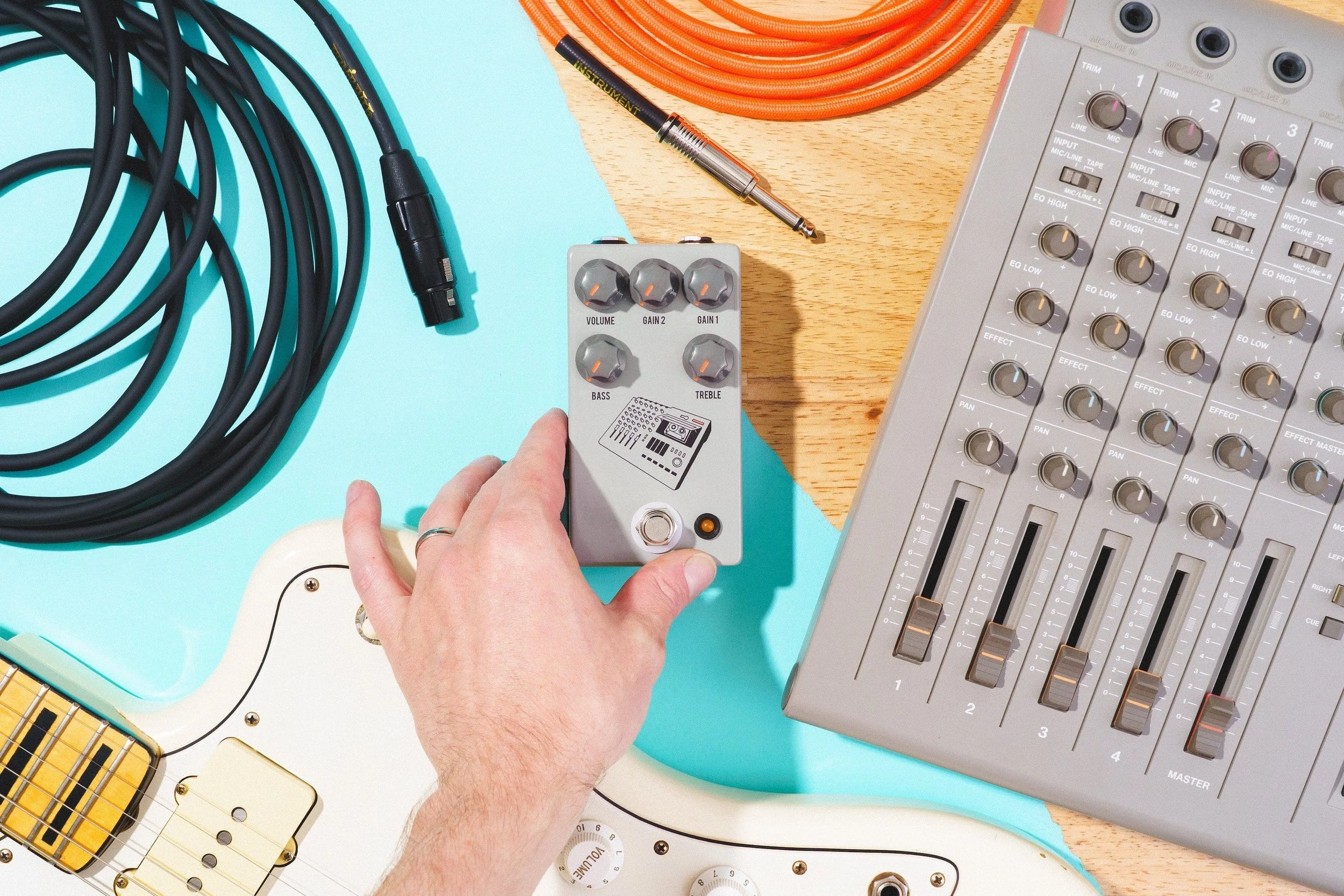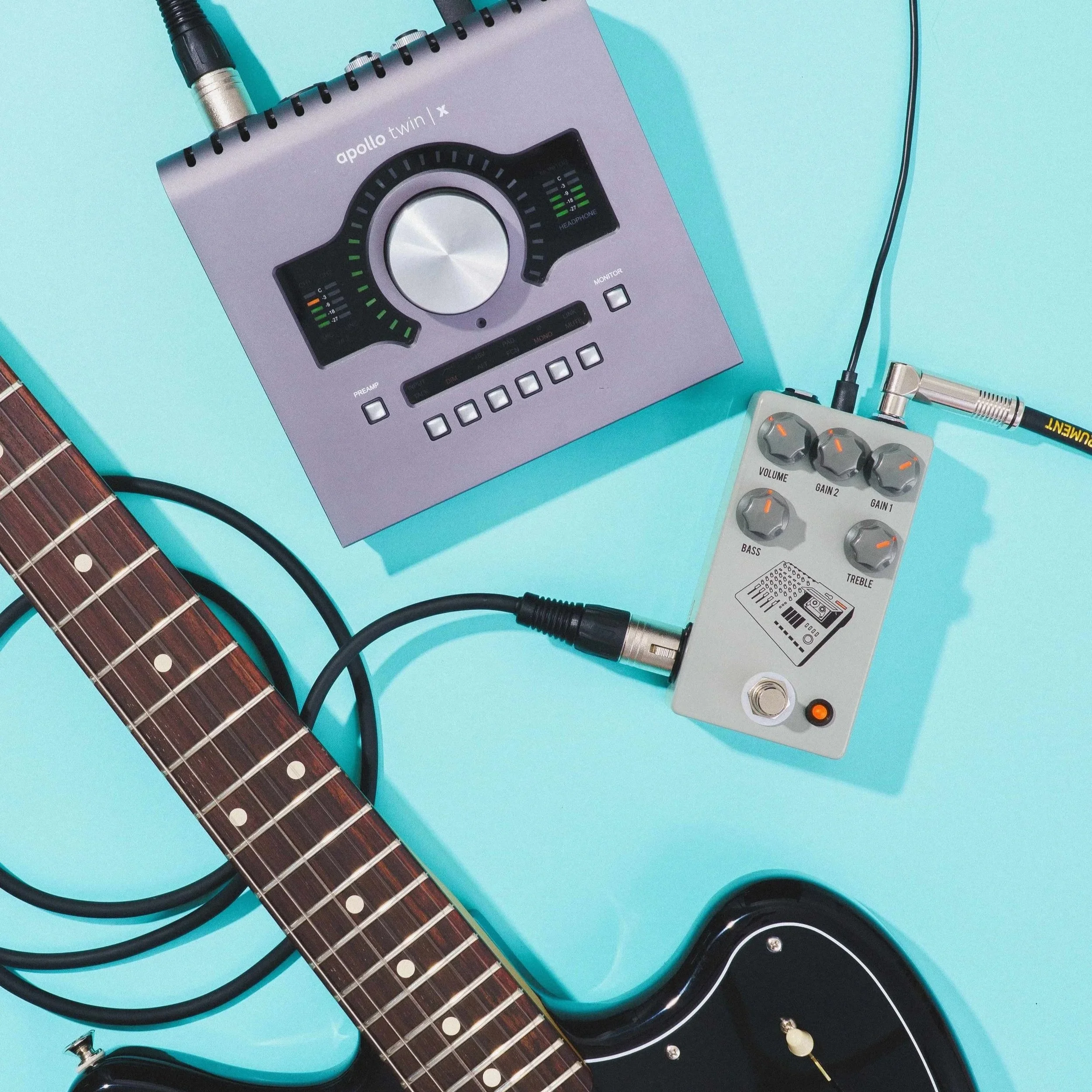JHS 424 Gain Stage Review: Should You Believe the Hype?

The JHS 424 Gain Stage isn’t your average overdrive or boost pedal — it’s a love letter to the golden age of home recording. Named after the Tascam Portastudio 424, this pedal brings the saturated preamp character of cassette-based multitrack recorders to your pedalboard. It’s not just about distortion or warmth, but the unique compression, noise, and harmonic smear that defined an entire era of indie and lo-fi music. For a company best known for transparent drives and boutique circuits, this move from JHS Pedals is both nostalgic and forward-thinking, tapping into a generation obsessed with imperfection and texture. What makes the 424 interesting is how it straddles two worlds: it’s built for guitarists but borrows its soul from studio hardware. With dual gain stages, a balanced XLR output, and circuitry inspired by the Portastudio’s mic preamps, it invites experimentation — whether you’re recording straight into your interface or shaping synths and drum machines. In a landscape flooded with amp sims and ultra-clean interfaces, the JHS 424 aims to bring back the dirt, hiss, and magic of analog tape. But does it really deliver that character, or is it just another nostalgia play? Let’s find out.
This site contains affiliate links. If you book or purchase through these links, I may earn a commission at no extra cost to you. This helps support the site and keeps my content free. As an Amazon Associate, I earn from qualifying purchases.
Design and Build
The JHS 424 Gain Stage looks like something pulled straight off a retro four-track recorder — and that’s entirely intentional. The pedal’s faceplate echoes the pastel colors and blocky layout of the original Tascam Portastudio 424, instantly triggering nostalgia for anyone who’s ever recorded on tape. It’s compact yet substantial, built in the same sturdy metal enclosure as other JHS pedals, with clearly labeled controls that make sense even if you’ve never touched a Portastudio before. The knobs are smooth and firm, the toggles reassuringly clicky, and the brushed-metal finish feels road-ready rather than precious.
Functionally, it’s divided into two gain stages — Input and Output — that mimic how a cassette recorder’s preamps could be pushed into natural compression or distortion. There’s also a balanced XLR output, which is unusual (and very welcome) for a guitar pedal, allowing the 424 to double as a DI or studio preamp. Inside, JHS used op-amps modeled on the Portastudio’s original NJM4565 and UPC4570 chips, keeping its sonic DNA authentic. Power requirements are standard 9V, and It uses a buffered bypass (not true bypass), so when disengaged it still passes through a buffer. Priced at around $349 USD, it’s positioned as a premium tool for players who value tone character over versatility — a boutique take on an obscure but beloved piece of gear history.
Sound and Tone Character
The first thing you notice about the JHS 424 is how alive it feels under your fingers. With the gain stages set low, it delivers a thick, rounded clean tone that adds warmth without dulling your transients — more like a gentle tape preamp than a clean boost. There’s a subtle compression that makes chords feel glued together, especially when tracking direct. It doesn’t sparkle like a high-fidelity preamp; instead, it adds a soft midrange push and a barely-there grit that instantly recalls cassette recordings from the ’90s. It’s this “recorded-on-tape” presence that gives it personality even before you push it into saturation.
Crank either gain stage and the 424 starts to bloom into gritty overdrive, the kind of breakup that sounds like the input meters of a Portastudio peaking in red. It’s not distortion in the traditional sense — it’s fuzzy, chewy, and uneven, with harmonics that spill out in unpredictable ways. There’s a natural compression that thickens single notes, while chords smear together beautifully without losing definition. Run it before a chorus or delay and it becomes a lo-fi textural machine; place it after fuzz and it tames harshness with analog sweetness. It even shines on non-guitar sources — drum machines and synths take on a dusty, sample-like character that’s hard to fake with plugins. The result is a pedal that doesn’t just color your signal — it makes it sound like it’s been recorded to tape, in real time.
In Use and Integration
What makes the JHS 424 special is how versatile it feels once you start experimenting with placement and sources. On a traditional pedalboard, it works beautifully as a front-end preamp, adding subtle saturation before drives or fuzzes. Used this way, it gives your entire chain a cohesive, recorded feel — as if you’re hitting a channel strip before tape. Some players prefer it last in the chain, where it can act as a mastering-style gain stage that glues everything together. Both positions work, but the results are dramatically different, making the 424 an easy rabbit hole for tone shaping.
In the studio, the balanced XLR output makes it far more than a guitar effect. Run it straight into your interface and it becomes a tactile alternative to plugin saturation — great for synths, drum machines, or even vocals. Push it hard and it behaves like an analog limiter, pulling down transients in a musical, tape-like way. You can even use it as a DI box for live sets, especially in minimalist rigs that skip amps altogether. It’s rare to find a pedal that feels equally at home on a desk and a pedalboard, but the 424 bridges those worlds effortlessly. This hybrid identity is where it really stands out: a studio-grade tool disguised as a stompbox.
Comparisons and Alternatives
While the JHS 424 carves out its own space, it inevitably invites comparisons. The most obvious point of reference is JHS’s own Colour Box V2, another studio-inspired preamp that models the sound of a Neve console. The Colour Box is broader in scope — with EQ, filters, and mic-level drive — but it’s also less immediate. The 424, by contrast, is simpler, rawer, and more focused, capturing the rough edges of cassette saturation rather than the polish of a console channel. Think of it less as a studio tool and more as an instrument in itself.
Among other pedals, the Benson Preamp and Hudson Broadcast both chase similar “preamp texture” territory, but they lean more toward amp-like breakup. The 424 feels dirtier and more unpredictable, closer to Chase Bliss Generation Loss mkII or Fairfield Circuitry Shallow Water in spirit — part tone-shaper, part vibe machine. And if your interest is specifically in the “tape sound,” pedals like the Strymon Deco or Keeley 30ms Double Tracker can get you there, but they lack the immediacy and analog grit of the 424. It’s a unique tool that doesn’t replace these alternatives so much as complement them, slotting perfectly into the modern lo-fi, bedroom pop, and experimental production scene.
Pros and Cons
Pros
Authentic Portastudio-style saturation with real analog character
Dual gain stages offer wide tonal range from subtle warmth to gritty fuzz
Balanced XLR output makes it ideal for direct recording and live DI setups
Works beautifully on guitar, synths, and drum machines
Inspires creative sound design and texture-based playing
Cons
No tone control or EQ section limits sculpting options
Can get noisy at extreme gain settings (part of its charm, but worth noting)
High price for an effect
Not suited for players seeking transparency or high-gain distortion
Verdict: Who It’s For
The JHS 424 Gain Stage is for players and producers who see imperfection as part of the instrument. It’s less about clean signal paths and more about color, compression, and personality. If you love the sound of tape saturation, vintage cassette recordings, or Mk.gee-style indie tones, this pedal will immediately click with you. It’s especially appealing for home recordists who want to inject analog depth into digital workflows without diving into racks or plugins.
That said, the 424 isn’t a one-size-fits-all solution. Traditionalists seeking a transparent boost or a flexible preamp might find it too idiosyncratic. But for those chasing vibe over precision — the kind of musicians who plug in, twist knobs, and record whatever happens — the JHS 424 is an inspiring little time machine. It’s one of those rare pedals that doesn’t just color your sound; it changes how you play and record.
This site contains affiliate links. If you book or purchase through these links, I may earn a commission at no extra cost to you. This helps support the site and keeps my content free. As an Amazon Associate, I earn from qualifying purchases.



